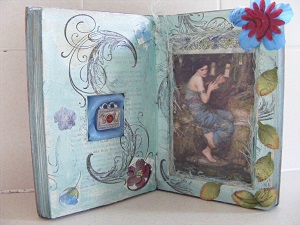Favourites on Friday - John William Waterhouse, painter
I was a fan of Waterhouse’s art even before I knew his name. His paintings are used for so many things – as book covers, in diaries, advertising … I honestly cannot remember the first painting of his that I saw, but I do know that his images were usually the first ones I came across in the myth/legend stories I read – like ‘The Odyssey’, ‘Echo and Narcissus’, ‘Psyche and Cupid’, ‘Apollo and Daphne’, ‘Pandora’s Box’ … And when I started papercrafting, his images were the ones I turned to time and again.
John William Waterhouse was born April 6, 1849 in Rome, where his father worked as a painter until the family returned to England in the 1850s. He was known as 'Nino' while in Rome, and the name stayed with him all his life.
In 1870, he entered the Royal Academy schools. His early works of classical themes showed the influence of Sir Lawrence Alma-Tadema and Frederick Leighton. His works were exhibited at the Royal Academy, the Society of British Artists and the Dudley Gallery. He made several trips to Italy in the late 1870s and early 1880s, where he painted genre scenes.
In 1883, he married Esther Kenworthy, and they took up residence at the Primrose Hill Studios; the couple did not have children. Although he painted primarily in oils, Waterhouse was elected to the Royal Institute of Painters in Watercolour in 1883, resigning 6 years later. He became ARA (of the Royal Academy of Arts) in 1885, and a full RA (Royal Academician) in 1895.
In 1884, his Royal Academy submission, ‘Consulting the Oracle’ garnered him favourable reviews. ‘The Lady of Shalott’, submitted for the Academy’s 1888 exhibition, revealed his growing interest in themes associated with the Pre-Raphaelites, especially those depicting strong or tragic females.

'Consulting the Oracle'

The Lady of Shalott
In the mid-1880s, Waterhouse started exhibiting with the Grosvenor Gallery, as well as galleries in Manchester, Birmingham and Liverpool. His paintings from this time, like ‘Mariamne’, were exhibited, not only in England, but also abroad. In 1900, he was the primary architect of the Artists’ War Fund.
Suffering from cancer, Waterhouse became increasingly frail in the final decade of his life yet continued to paint until his death on February 10 1917. One of his final works was ‘The Enchanted Garden’, left unfinished on his easel at his death; it is now in the collection of the Lady Lever Art Gallery in Liverpool.
Considering Waterhouse was an active member of the Royal Academy, surprisingly little is known about his personal life. He left no diaries or journals, and only a few letters have survived.
According to Peter Trippi, in his book ‘J.W. Waterhouse':
“ … Waterhouse is among the most popular Victorian Artists, and many of his paintings have become icons of femininity recognized the world over. With the glowing colour, compelling composition and Impressionist-infected technique, these paintings are admired for their beauty, yet at the same time have the power to transport viewers into a romantic world of myth and legend. Waterhouse’s art reflects, not only his distinctive ideal of female beauty, but also a lifelong fascination with the Romantic and Symbolistic themes of passion, magic and transformation, spiritual, erotic and physical … like other Victorian artists, Waterhouse was neglected throughout much of the 20th century, but today he is acknowledged as a crucial inheritor of the Pre-Raphaelite legacy.”
I make no excuses for the number of pictures that follow; I love his art so much I find it hard to choose one over another, so here they are in no particular order ...

Apollo and Daphne

Ariadne

Boreas

Circe Offering the Cup to Ulysses
(I have a print of this on the wall next to the computer)

Echo and Narcissus

Fair Rosamund

Hylas and the Nymphs

Lamia

Mariana in the South

Miranda (The Tempest)
Waterhouse did 3 paintings of Ophelia ...

Ophelia (1889)

Ophelia (1894)

Ophelia (1910)

Pandora

Penelope and the Suitors

Psyche Entering Cupid's Garden

Psyche Opening the Golden Box

The Magic Circle

The Mystic Wood

The Soul of the Rose

Mariamne Leaving the Judgement Seat of Herod
This is one of Waterhouse's most dramatic paintings. Mariamne was considered to be the favourite of King Herod’s 10 wives. He loved her dearly, but allowed himself to be swayed by false rumours of unfaithfulness brought to him by her sister, Salome. Herod put Mariamne on trial, and with great despair sentenced her to be executed. In the painting, Mariamne is depicted with arms bound, and fists clenched as she stares at her husband, Herod, in hurt disbelief. King Herod, unable to bring himself to look at her, drops his head to avoid her gaze. Her dress is white, symbolizing her purity and innocence of the crime.

The Enchanted Garden - Waterhouse's unfinished painting




